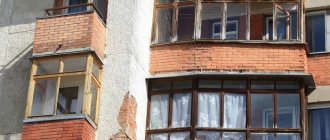If you are interested in how to become the owner of not a share, but a room in an apartment, just type in a search engine the phrase “partition of apartment shared ownership.” For this phrase, the search engine will find you millions of pages with similar information (Yandex, for example, finds more than two million). It is difficult to obtain the necessary information from this multitude.
Here we will describe in detail and clearly the procedure for allocating a share in an apartment, how a share in common property differs from a share in a communal apartment, and what to do correctly in the event of selling a share in a communal apartment.
Commentary on Article 42 of the RF Housing Code
1. The size of the share in the right of common ownership of common property in a communal apartment is determined based on the fact that the specified share is proportional to the size of the total area of the room belonging to the owner in this apartment. At the same time, the total area of the room belonging to the owner does not include the area of balconies, loggias, verandas and terraces (see Part 5 of Article 15 of the Code).
If in a communal apartment the owner owns two (or more) rooms, then it should be assumed that this circumstance in itself should not be taken into account when determining the size of his share in the right of common ownership, since the decisive factor in this case is not the number of living rooms, but their total area.
Thus, the shares of participants in common ownership in a communal apartment are not equal. Therefore, in this case, the rules of civil law on shared rather than joint ownership apply. In this regard, it is advisable to keep in mind that the share of a participant in shared ownership can be increased according to the rules of the first paragraph of clause 3 of Art. 245 of the Civil Code of the Russian Federation, if this participant has carried out at his own expense inseparable improvements to the common property.
2. The owner of a room in a communal apartment, in addition to the right to a share in the ownership of the common property in this apartment, also has a share in the ownership of the common property in an apartment building. It is proportional to the sum of: a) the size of the total area of the specified room and b) the size of the area of the premises constituting the common property in this apartment, determined in accordance with the share of the given owner in the right of common ownership of common property in a communal apartment.
3. In accordance with the principle underlying Part 2 of Art. 37 of the Code, part 3 of Art. 42 contains a mandatory rule on the succession of the share in the right of common ownership of common property in a communal apartment of the owner of the room to the fate of the right of ownership of the room belonging to this owner. In the event that the owner of a room in a communal apartment alienates his room to another person (sells, donates, exchanges, etc.), not only the ownership of the specified room passes to the new owner (acquirer), but also the ownership of the room that belonged to the previous owner share in the right of common ownership of common property in a communal apartment.
4. In cases where the ownership of a room in a communal apartment is transferred to another person on the basis of a transaction or by inheritance, the share in the right of common ownership of the common property in this apartment passes unchanged to the new owner.
5. Imperative norms, part 5, art. 42 of the Code prohibit the owner of a room in a communal apartment from committing actions that violate the principle that the share in the right of common ownership of the owner of a room in a communal apartment follows the fate of the ownership of the specified room (see Part 3 of Article 42 of the Code). See also commentary to Art. 38 of the Code.
BN Help
What is possible and what is not possible when remodeling
It is forbidden
– Place toilets and bathrooms above living rooms and kitchens located on the floor below. There is only one exception to this rule: the case when the lower floor is also yours (for example, in a two-level apartment)
– Expand kitchens due to the area of living rooms and bathrooms
– Increase the area of bathrooms at the expense of living rooms and kitchens
– Move central heating radiators to the loggias (regardless of whether it is insulated or not)
– Touch and hide risers for gas supply, heating, water supply and sewerage in the walls
Can
– Combine and divide living rooms (each new living space must have a window, an area of 9 sq. m and a width of at least 2 m), the only room in the apartment is at least 14 sq. m. m
– Increase the hallway, pantry, wardrobe to the living room area
– Combine the toilet and bathroom by making a combined bathroom
– Enlarge the kitchen, bathroom or toilet due to the corridor, hall, hallway, pantry, common areas
– Place the bathroom above the non-residential premises or hallway of the apartment located below (of course, if technical capabilities are available)
Article 43 of the RF Housing Code. Maintenance of common property in a communal apartment
6. The right of first refusal is the right of participants in common shared ownership in relation to a share in their property sold to an outsider at the price for which it is sold, and on other equal conditions, except in the case of sale of such a share at public auction. Assignment of the right of pre-emption to purchase a share is not permitted.
According to Art. 250 of the Civil Code of the Russian Federation, public auctions for the sale of a share in the right of common ownership in the absence of consent to this from all participants in shared ownership can be held in cases provided for in Part 2 of Art. 255 of the Civil Code of the Russian Federation, and in other cases provided for by law.
The seller of a share is obliged to notify in writing the other participants in shared ownership of his intention to sell his share to an outsider, indicating the price and other conditions under which he sells it. If the remaining participants in shared ownership refuse to purchase or do not acquire the sold share in the ownership of real estate within a month from the date of notification, then the seller has the right to sell his share to any person.
When selling a share in violation of the right of first refusal, any other participant in shared ownership has the right, within three months, to demand in court the transfer of the rights and obligations of the buyer to him.
The stated rules also apply when alienating a share under an exchange agreement.
In accordance with paragraph 1 of Art. 24 Federal Law of July 21, 1997 N 122-FZ “On state registration of rights to real estate and transactions with it”, when selling a share in the right of common ownership to an outsider, documents confirming that the seller of the share notified the others in writing are attached to the application for state registration participants in shared ownership about their intention to sell their share, indicating the price and other conditions on which they are selling it.
The application for state registration may be accompanied by documents confirming the refusal of the remaining participants in shared ownership to purchase a share and drawn up by the body carrying out state registration of rights or notarized. In this case, state registration of the right to a share in common property is carried out regardless of the period that has passed since the seller notified the share to the remaining participants in shared ownership.
If the application for state registration is not accompanied by documents confirming the refusal of the remaining participants in shared ownership to purchase the share, the state registrar is obliged to suspend state registration until the expiration of a month from the date the seller of the share notified the remaining participants in shared ownership, if on the day of filing the application for state registration such the deadline has not expired.
Disputes between participants in shared ownership that arise during state registration of the right to a share in common property are subject to resolution in court.
Main factor: neighbors below
It happens that the seller of a “studio room” presents a spectacular project made by a design studio and assures that approval of the redevelopment is almost a resolved issue. Don't rush to rejoice.
“Legitimate” small-sized apartments obtained as a result of redevelopments are found in listings, but rarely. Looking closely at such objects, you will certainly notice that they are located mainly on the first floors, and if on the second or third, then above non-residential premises - offices and shops. Why?
It's simple. In accordance with today's residential complex requirements, your bathroom should only be located above another bathroom or hallway, and there cannot be living rooms under the kitchen. Otherwise, there is not the slightest chance of legitimizing this redevelopment.
It is possible to legalize redevelopment, for example, on the middle floor if underneath there is an object of a similar layout with an already legalized modernization. But for this, it is necessary that all apartment owners, starting from the bottom, go through the entire process from approval of the redevelopment project to commissioning and receipt of documents for the newly formed property. Needless to say, in real life this is an almost impossible task!
But you will have to not only take into account the interests of the neighbors below, over whose heads you do not have the right to place your toilet, but also negotiate with the neighbors on the side: in order to carry out any redevelopment in a communal apartment, the written consent of all owners is required.
Another comment on Art. 42 of the Housing Code of the Russian Federation
1. The share of the owner of the room (rooms) in the right of common ownership of the common property of a communal apartment is determined in proportion to the total area of the room (rooms). Calculation of the total area of the room: the area of the auxiliary premises is divided by the number of rooms in the communal apartment. The part of the auxiliary premises per room and the living area of the room gives (in total) the total area of the room. This area is the basis for determining the share in the right of common ownership of common property in a communal apartment - in proportion to the total area of the room.
2. A share in the right of common ownership of common property in a communal apartment is an integral part of the room and always follows the fate of the ownership of it. When the owner of a room changes, the share of the new owner in the right of common ownership is equal to the share of the previous owner.
The owner of a room in a communal apartment is deprived of the opportunity to allocate in kind his share in the right of common ownership of the common property of a communal apartment and to alienate it separately from the alienation of the room.
3. When selling a room in a communal apartment, the remaining owners of the rooms have a pre-emptive right to purchase this room in the manner and under the conditions established by the Civil Code of the Russian Federation.
The procedure for selling a share is as follows: the seller is obliged to notify in writing the owners of all other rooms in this apartment of his intention to sell his room, indicating the price and other conditions under which it is being sold. Any of the other owners has the right to buy it on these terms within a month; otherwise, the owner has the right to sell his room to any person (Article 250 of the Civil Code of the Russian Federation).
If the seller violates the preemptive right of the owners of other rooms, any of them may, within 3 months, demand the transfer of the rights and obligations of the buyer to him. To do this you need to go to court.
Today on the real estate market, developers only offer areas of approximately 30 square meters or more, and shared ownership allows you to purchase an area of 16 to 30 m2, much cheaper than the market price for an apartment. The cost of a share in an apartment with city registration in a ready-made house that has already been commissioned starts from 1,200,000 rubles, and this is not a room, but a studio with a control room and a kitchen. It is actually possible to buy an apartment from a developer, not of a large area, today, but you will only be able to live there in 2021. Our company has developed a package of documents that allows us to eliminate possible disadvantages of shared ownership at the stage of purchasing an apartment and allows us to regulate the legal relations of new owners among themselves within the framework of common ownership. You can start using and managing your property today.
1) Purchasing your share from 1 owner or developer company directly without intermediaries.
Benefits:
— there is no increase in the price of the object
- no risk of losing money
2) Notarized waiver of the priority right to purchase a share in the apartment from all future owners
Benefits:
- you can sell your share in the property without notifying all owners
— no need to wait a month for consent, because refusals have already been received and are stored by the notary
3) A notarized agreement on the procedure for using the apartment allocates your share of the property in square meters and determines your area on the apartment plan.
Benefits:
- regulates legal relations between owners
- such a document allows you to pledge a share to the bank
— the document determines the procedure for using common areas and allocates your property in common ownership
In fact, you get a separate studio apartment with your own control room and kitchen area in the studio.
1) Each studio is equipped with its own metered electricity network, which does not depend on your neighbors. The apartment has a common meter for the corridor and a separate one for your studio.
2) Own separate meters are installed for water.
3) The layout, as a rule, does not need to be legalized, because We do not dismantle load-bearing walls and do not change the boundaries of the entire apartment. We do not install or locate wet areas above residential areas. The redevelopment is carried out by a legal entity in accordance with GOSTs and SNIPs adopted in the Russian Federation and has the right and permission to perform this type of work. As follows from the law:
Based on Article 26 of the Housing Code of the Russian Federation, there is no need to obtain permission from the Housing Inspectorate and coordinate the project in order to carry out the following types of work:
- installation of glazing on a loggia or balcony (but without changing the appearance of the facade);
- sealing or moving, expanding or reducing door openings in the internal partitions of the apartment, with the exception of load-bearing and inter-apartment partitions;
— demolition and installation of partitions that are not load-bearing and do not increase the load on the floors (wooden, plasterboard, less often brick, etc.);
— replacing the bathtub with a shower cabin;
- moving the stove within the kitchen.
4) With the above documents you receive:
allocated share in the property, which you can ATTENTION!!!
- buy, sell, bequeath, donate, lease, obtain registration in this property, mortgage it to the bank. The only difference will be a common cadastral number with several owners. General mailbox. Agree for a 30% discount on the cost per square meter, you can try to change your attitude towards this type of property))
5) It is possible to legalize the redevelopment of an apartment at the request of the owners; as a rule, a project is required, permission for redevelopment; the cost of turnkey documents can be around 200,000 rubles for 1 apartment. And for a period from 2 months to six months.
NOTE:
As the housing code of St. Petersburg says, paragraph 6 of Art. 1 (Law dated July 16, 2001, No. 572-73, as amended on November 18, 2002): “ A communal apartment is an apartment in the state housing stock of St. Petersburg or municipal housing stock, the residential premises in which are occupied under separate agreements ( social hiring, hiring, rent) by two or more employers (tenants) who are not spouses, parents, children or family members of the employer.”
If you can't, but really want to
From all of the above, it becomes clear why owners of studio apartments in the old building are in no hurry to legalize redevelopment. They probably want to, but they can't. And the point is not that this is a long and expensive process. And the fact is that the ending is unpredictable: there are too many objective and subjective factors, any of which can put an end to the initiative.
What are the dangers of illegal redevelopment? You can live in an “improved” room, and you can sell it too (illegal redevelopment is not an obstacle to the transaction). But it won't become an apartment.
What else are they doing? If the room is spacious and adjacent to the kitchen or bathroom, sewer and water supply pipes are “smuggled” into it. This allows you to place on your space a mobile kitchen corner with an electric stove, sink and boiler, as well as a shower stall behind a collapsible partition. To do this, pipe outlets and water sockets are made in the room. And if necessary, the room can be quickly returned to its original state. Such improvements make life easier, but are also illegal. This means that in the event of a utility failure, cracks in the walls and leaks to the neighbors, the owner of a property with illegal redevelopment and connections to the network will almost certainly be “assigned to the extreme”.
Text: Philip Urban Photo: pixabay.com
Housing law in Russia
Communal apartments also include apartments from the state housing stock of St. Petersburg that meet the requirements of this definition, in which part of the residential premises has become the property of citizens, despite the fact that at least one premises (residential) is owned by the state. The Moscow Housing Code on communal apartments in Article 15 (Law dated March 11, 1998, No. 6, as amended on July 10, 2002) says this: “A communal apartment is an apartment consisting of several residential premises (rooms) belonging to two and more users and/or owners who are not members of the same family, on the basis of separate agreements, transactions, other actions provided for by law, sharing auxiliary premises (common areas of the apartment) and engineering equipment in common areas.”
CONCLUSIONS suggest themselves! Shared ownership allocated through a notarial agreement has nothing in common with a communal apartment.
Try to answer these questions for yourself:
Why legitimize redevelopment done by a construction company in accordance with GOST if the law does not require it?
Why do you need your own separate cadastral number?
What are “common areas” in an apartment and “common areas” on a landing and how do they differ?
If an apartment building is built in shares according to the shared ownership agreement and no questions arise, why and what questions arise when living in common property?
1. Regime of common shared ownership in a communal apartment
The share in the right of common ownership of common property in a communal apartment of the owner of a room in a given apartment is proportional to the size of the total area of the specified room.
2. The share in the right of common ownership of common property in an apartment building of the owner of a room in a communal apartment located in this house is proportional to the sum of the dimensions of the total area of the specified room and determined in accordance with the share in the right of common ownership of common property in the communal apartment of this owner of the area premises constituting the common property in this apartment.
3. The share in the right of common ownership of common property in a communal apartment of the owner of a room in this apartment follows the fate of the right of ownership of the specified room.
4. When transferring ownership of a room in a communal apartment, the share in the right of common ownership of the common property in this apartment of the new owner of such a room is equal to the share in the right of common ownership of the specified common property of the previous owner of such a room.
5. The owner of a room in a communal apartment has no right:
1) to allocate in kind his share in the right of common ownership of common property in a given apartment;
2) alienate his share in the right of common ownership of the common property in this apartment, as well as perform other actions entailing the transfer of this share separately from the right of ownership of the specified room.
6. When selling a room in a communal apartment, the remaining owners of rooms in this communal apartment have a pre-emptive right to purchase the alienated room in the manner and under the conditions established by the Civil Code of the Russian Federation.
Rules and exceptions
In older buildings there are “dimensionless” communal apartments, including those with rooms and halls of up to 40 square meters. m and four-meter ceilings, which can accommodate not just a studio, but even a two-level apartment. But if there are living rooms under the “hall”, the kitchen and bathroom in it cannot be legalized in principle.
Buying an apartment with redevelopment: what to look for Modern renovation is not only about fresh wallpaper. Today's owners can easily >>However, there are no rules without exceptions. In some pre-revolutionary houses there are legal apartments with initially studio layouts - for example, janitors' rooms on the ground floors or so-called furnished rooms (rooms as apartments). In particular, there are such apartments in the famous Tolstoy house on Rubinshteina Street, 15 (total area - 25 sq. m, ceilings 3.4 m, kitchen nook and bathroom at the entrance, second level with a sleeping mezzanine).
But this is what was originally designed as a corridor system and furnished rooms. In Soviet and post-Soviet times, some residents of the old building also managed to legalize bathrooms and kitchens that did not meet today’s requirements of SNiP and housing legislation - with walk-through kitchens, bathtubs in kitchens and toilets above the kitchens of neighbors below.
You can't do that today. The “kitchen in the hallway” option, typical of former dormitories and some previously modernized apartments of the old foundation, is already “unusable”: in accordance with current standards, there must be a window in the food preparation room.
Commentary to Art. 42 Residential Complex of the Russian Federation
1. Similar to the share in the right of common ownership of the common property of an apartment building, the commented article establishes the presence of a share in the right of common ownership of each owner of an isolated residential premises in a communal apartment in the right to common property in this apartment. This share is proportional to the size of the residential premises in the apartment owned by the owner. Based on the size of the share in the ownership of common property in a communal apartment, the owners of residential premises in such an apartment bear the burden of expenses for maintaining the common property in this apartment (see commentary to Article 43 of the Housing Code).
2. This Code establishes the same structure for the transfer of ownership of a share in the right of common ownership of common property in an apartment building. A share in the right of common ownership of common property is an integral part of the premises and always follows the fate of the ownership of it. When the owner of a premises changes, the share in the right of common ownership of common property in an apartment building for the new owner of the premises is always equal to the share of the previous owner of this premises.
The owner of an isolated living space in a communal apartment also has a share in the ownership of common property in an apartment building.
The share in the ownership of common property in an apartment building of the owner of an isolated residential premises in a communal apartment is proportional to the size of the residential premises owned by him and the size of the common property of the communal apartment in accordance with his share in the ownership of the common property in the communal apartment.
4. Similar to the rules for the common property of an apartment building and shares in the right of common ownership of it, the rules for the common property of a communal apartment and shares in the right of common ownership of it should be applied.
This is due to the purpose and specific features of the objects that are common to residents of a communal apartment.
5. When selling isolated residential premises in a communal apartment, the remaining owners of residential premises in this apartment have the right of first refusal in the manner and under the conditions provided for by the Civil Code of the Russian Federation. The Civil Code establishes only one case of exercising the right of pre-emption - the acquisition of a share in the right of common ownership by other participants in shared ownership (Article 250). But in this case, it would be better if in the commented article the procedure and conditions for the sale of isolated residential premises in a communal apartment were described.
5. Using the analogy of Art. 250 of the Civil Code of the Russian Federation, the owner of an isolated residential premises in a communal apartment is obliged to notify in writing the other owners of isolated residential premises in this apartment of his intention to sell the premises owned by him, indicating the price and other conditions on which he is selling it. If the remaining owners of residential premises in the apartment refuse to purchase or do not purchase the residential premises being sold within a month from the date of notification, then the owner of an isolated residential premises in a communal apartment has the right to sell it to any person.
When selling residential premises in a communal apartment in violation of the preemptive right to purchase, any other owner of residential premises in this apartment has the right, within three months, to demand in court the transfer of the rights and obligations of the buyer to him.
By analogy with Art. 255 of the Civil Code of the Russian Federation, in the event of a foreclosure on an isolated residential premises in a communal apartment, the creditor has the right to demand that the debtor sell this residential premises to the remaining owners of residential premises in this apartment at a price commensurate with the market value of this residential premises, with the proceeds from the sale being used to repay the debt.
If the remaining owners of residential premises in a communal apartment refuse to purchase the debtor’s residential premises, the creditor has the right to demand in court foreclosure on the debtor’s residential premises by selling this share at public auction.
The bottleneck of technical capabilities
Now let's look at the basic sanitary, technical and construction restrictions, of which there are a great many. Thus, installing a gas stove and water heater will be allowed only if there is a window in the kitchen and it is possible to organize an exhaust hood.
The problem with the hood is solvable: in the walls of old houses there are almost always inactive chimneys, which can be reached with corrugated air ducts. However, the living room must be separated from the room where the gas equipment is located by a partition with a door - which is impossible with a studio layout.
Acceptance of an apartment from a developer: finding out the nuances
How to save money for an apartment
How to reduce finishing costs
Daily rent: getting the most out of an apartment
Interest-free loan: savings for those on the waiting list
Installing an electric boiler and electric stove allows you to bypass the restrictions. But another problem arises: there may not be free capacity (and supplying organizations are obliged to provide individual consumers with electricity at the rate of 3 kW per apartment). More precisely, they almost certainly do not exist: in old buildings, crammed with communal apartments and non-residential facilities on the ground floors, they are almost always in short supply.
Next: a kitchen niche in one-room apartments should be from 5 square meters. m (if there is no gas equipment), entry to the toilet from the kitchen and room is not allowed. This means a hallway is needed. Accordingly, the living room must have a window more than 2 meters wide and an area of 9 square meters. m, and if this is the only room in the apartment, then 14 sq. m.
By the way, intra-house and external networks are another weak link. Indeed, in old houses, in addition to the housing stock, many commercial consumers are usually connected to them. Therefore, it is not easy to obtain approvals.
As redevelopment specialists once explained to us, the situation is as follows. In principle, district interdepartmental commissions (IMC) of central districts almost always have the opportunity to “fit” another apartment into an apartment building. But there are many more people who want to “break up” with their neighbors. Therefore, MVK leaders try not to create precedents for mass appeals.
Subtotal. Based on the above, a room with at least two windows, located on the first residential floor, and having a total area of at least 28 square meters has a chance to turn into a separate apartment. m, if technically possible, connect to intra-house networks (water supply, sewerage, heat supply) and organize a separate entrance.









